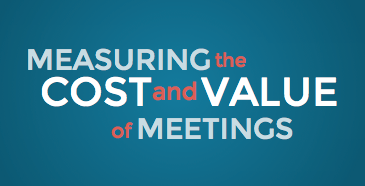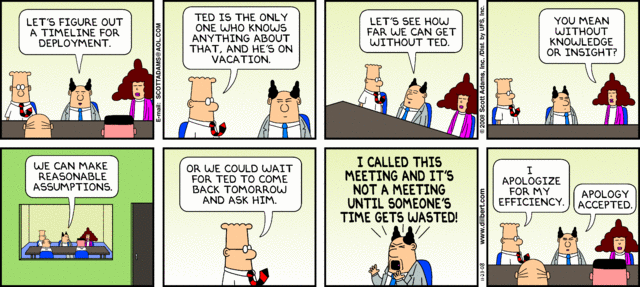Measuring the Cost and Value of Meetings: Part I – Software Costs
Part I: Software Costs

As you may have seen, we recently announced new pricing for Lucid Meetings. You may have wondered how we arrived at the prices we did. Then again, maybe you didn’t. Either way, prepare to be informed.
We wanted to make sure we could save teams money on their software costs, and to do that, we needed to do some research. What do teams pay for their meeting software today? Our investigation revealed three main ways that people use and purchase software for collaborative meetings.
The Free Lunch
You can absolutely cobble together a meeting solution out of free bits of software. Many small, especially one-person businesses are successful in doing so.
Free services work great for prosumers: those individuals that use online services infrequently or who can take the time to continually test, combine, and switch out technologies.
Collaboration Software
The collaboration software market includes products spanning a dizzying array of product features designed to solve a smorgasbord of business problems for a panoply of prices.
Adoption is uneven, with some companies investing hundreds of thousands of dollars in enterprise collaboration suites while others simply trust their shared information to their email inboxes.
When looking at what an average team spends for collaboration software, getting an apples to apples comparison is next to impossible. When trying to figure out what portion of this budget supports their project meetings, we can’t even stay in the produce department.
Since most teams would use Lucid Meetings to supplement or integrate with their existing software, we don’t measure these costs as a direct part of the meeting cost calculation.
Web Conferencing and Conference Calls
Web conferencing and conference calls make up the bulk of a team’s meeting software expense. Most organizations pay about $40 per host for web conferencing and .05 – .13 cents per minute for toll-free calling.
Cisco WebEx is the long-standing industry leader in this market. Cisco WebEx and its web conferencing cousins were born to solve the problem of how you could share a presentation (usually a sales deck) in real time with someone at a different location. Most include toll and VoIP conference calling and offer packages of toll-free calling minutes.
Lucid Meetings can also be used to share a presentation with your remote team and hold a conference call, and while this basic communication issue is only a part of the problem we’re working to solve, comparing our prices to those of web conferencing vendors is the most direct comparison as far as software costs are concerned.
Problem is – it’s complicated! The leading web conferencing vendors rely heavily on feature-gating (where they hold back features to get you to buy a more expensive product) and long-term contracts to drive revenue. Below are just a few of the factors you have to wade through when figuring out how to get the best deal.
-
Number of hosts / meeting rooms
-
To figure out how much you’ll spend, you need a sense of how many people have to run online meetings. Companies choose the number of hosts based on the number of employees in a given role (sales, executives, project managers) and then fudge a bit by either sharing passwords or subscribing to extra accounts.
Our prices are based on the number of teams/business units or projects your organization runs. Each room can have several people who “run” the meeting, so your costs stay in line with your funded departments and programs rather than the number of personal accounts used.
For the purpose of pricing comparison, though, we’ll treat a web conferencing host as roughly analogous to a Lucid meeting room.
-
Maximum number of participants
-
Web conferencing vendors offer cheaper version of their software for meetings with a limited number of attendees. If you know for a fact that you’ll never have more than 8 people on a call, you can get a screaming deal.
If you might have a 9th person join some day, you’ll need the more expensive account. If you need more than 25 (or in some cases more than 15), then you need the much more expensive account.
-
Annual contracts and enterprise pricing
-
The best web-conferencing deals are available only when you commit to pay for a minimum number of hosts for a full year. The industry leaders all publish pricing on their websites and make it easy for new customers to sign up without a contract, but only for a limited number of accounts.
To find out what the price for 10 or more meeting hosts might be, you need to contact a sales representative. Cisco WebEx, GoTo Meeting and other leading services are also big business for resellers, who work to aggressively sell large annual subscriptions to medium and large companies.
If you’re part of a large enterprise with gobs of web conferencing accounts, you’re probably working with one of these outside sales people to get a per-host price much lower than those published on the conferencing provider’s website.
We offer accounts for unlimited rooms with no annual commitment directly through our website, meaning we don’t need to cover the costs of sales commission. For comparison purposes, we only looked at the prices available from the web conferencing vendors under the same no-long-term commitment conditions.
Unfortunately, once you’re working in any kind of volume, the comparison breaks down – you simply can’t get there from here. The big web conferencing vendors are very focused on and very good at locking organizations into an inflexible annual contract, and the terms of those vary considerably from organization to organization.
-
Conference calling minutes
-
This one’s the doozy. Let’s start by explaining that many companies make far more money in conference call fees than they do from web conferencing account subscriptions. To see why this is, you need to understand how call minutes work.
First, the price you pay is per minute PER CALLER.
Example:
You hold a 1-hour meeting with 5 people for which you pay 10 cents/minute.
Your phone bill is $30. (60 minutes * 5 callers * $0.10 = $30.00)Second, there are many types of phone minutes.
- Toll Calling and VoIP:
Vendors usually include some large (but not always unlimited) amount of Toll or VoIP minutes. The cost of a toll call is charged back to the people calling in, and in the days of unlimited long distance plans becomes fairly invisible for callers in the US. VoIP connections work through participants’ computers, and the costs are built into the base subscription price. - Toll-free and International Calling
Toll-free calling minutes are charged to the meeting host rather than the meeting guests, which makes this the preferred option for meetings with prospects, clients, and others outside the organization. Companies buy toll-free minutes in packs of 500 or more per month or on a pay-as-you-go basis, with the per-minute rate decreasing when you commit to a higher package.
To figure out what you’ll spend on conference calling, you need to know:
- What kind of minutes you use: toll, toll-free, VoIP
(If you use all of these, you need to know the mix.) - How long on average your meetings last
- How many people on average call in to your meetings
- Toll Calling and VoIP:
Got all that?
The Payoff: A Web Conferencing Price Calculator!!!
Given all these rules and conditions, it was hard to see just how our prices compared and whether we would indeed help teams save money. Happily, the answer in most cases is a solid Yes!
To help you make the same comparisons, we put together this handy dandy pricing comparison calculator based on the published retail prices for Lucid Meetings. Sliders show how the costs change as you increase the number of hosts, callers, meetings, etc, and they’re just darn fun to play with.
Give it a whirl, share with a friend, and let us know what you think. Did we miss something? We’d love to hear from you.
Related Posts
You may also be interested in the other posts in this series about measuring the cost and value of meetings:
Part I – Software Costs



